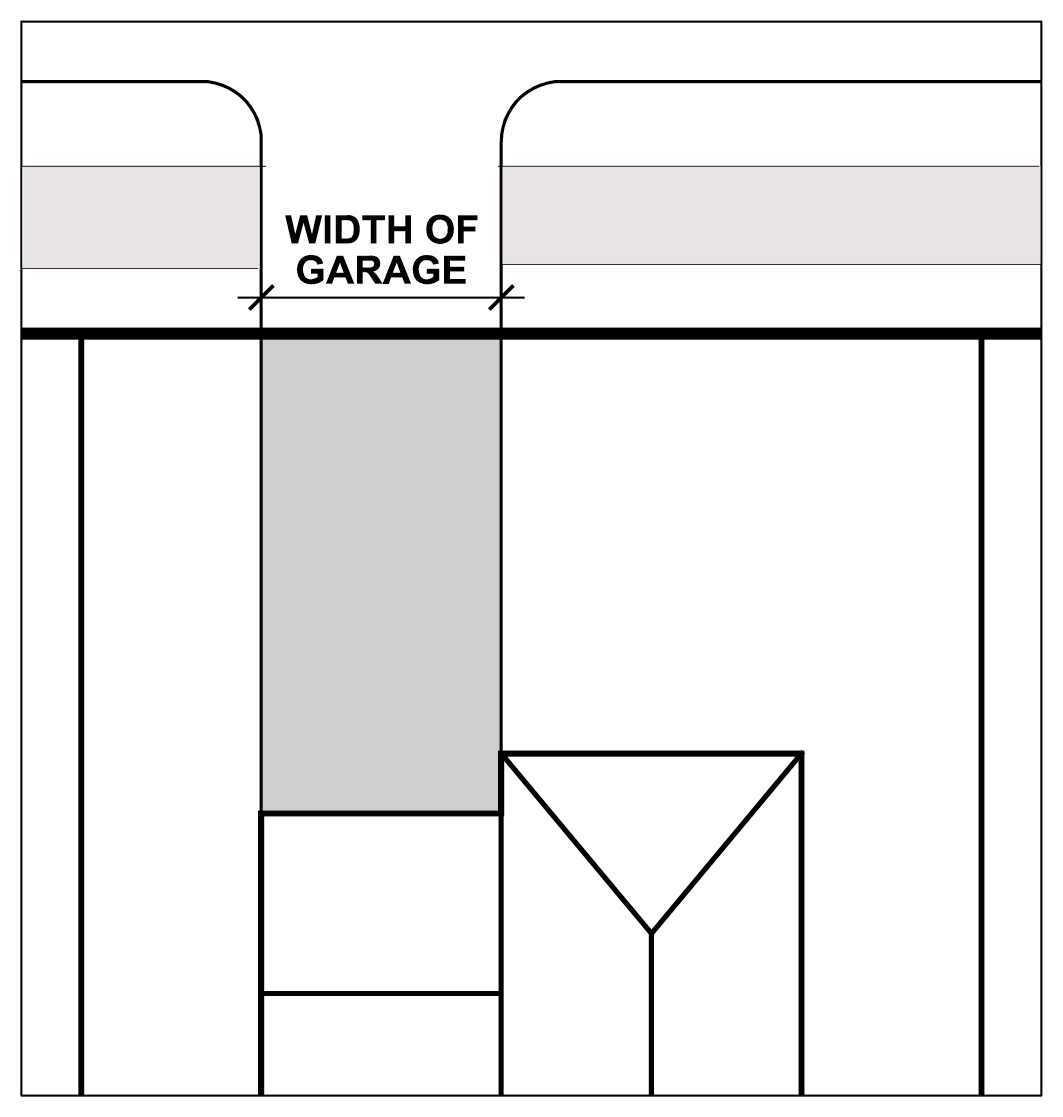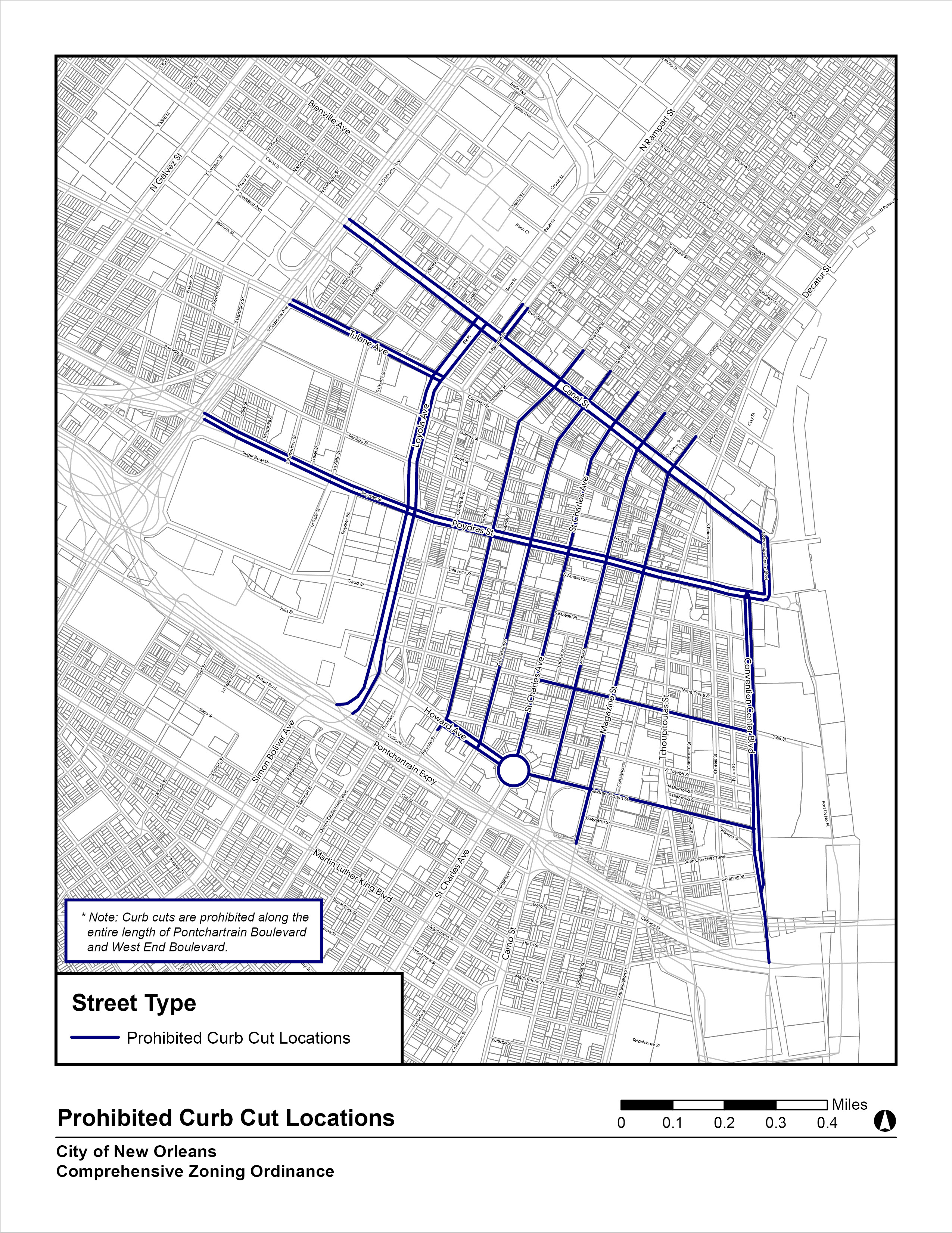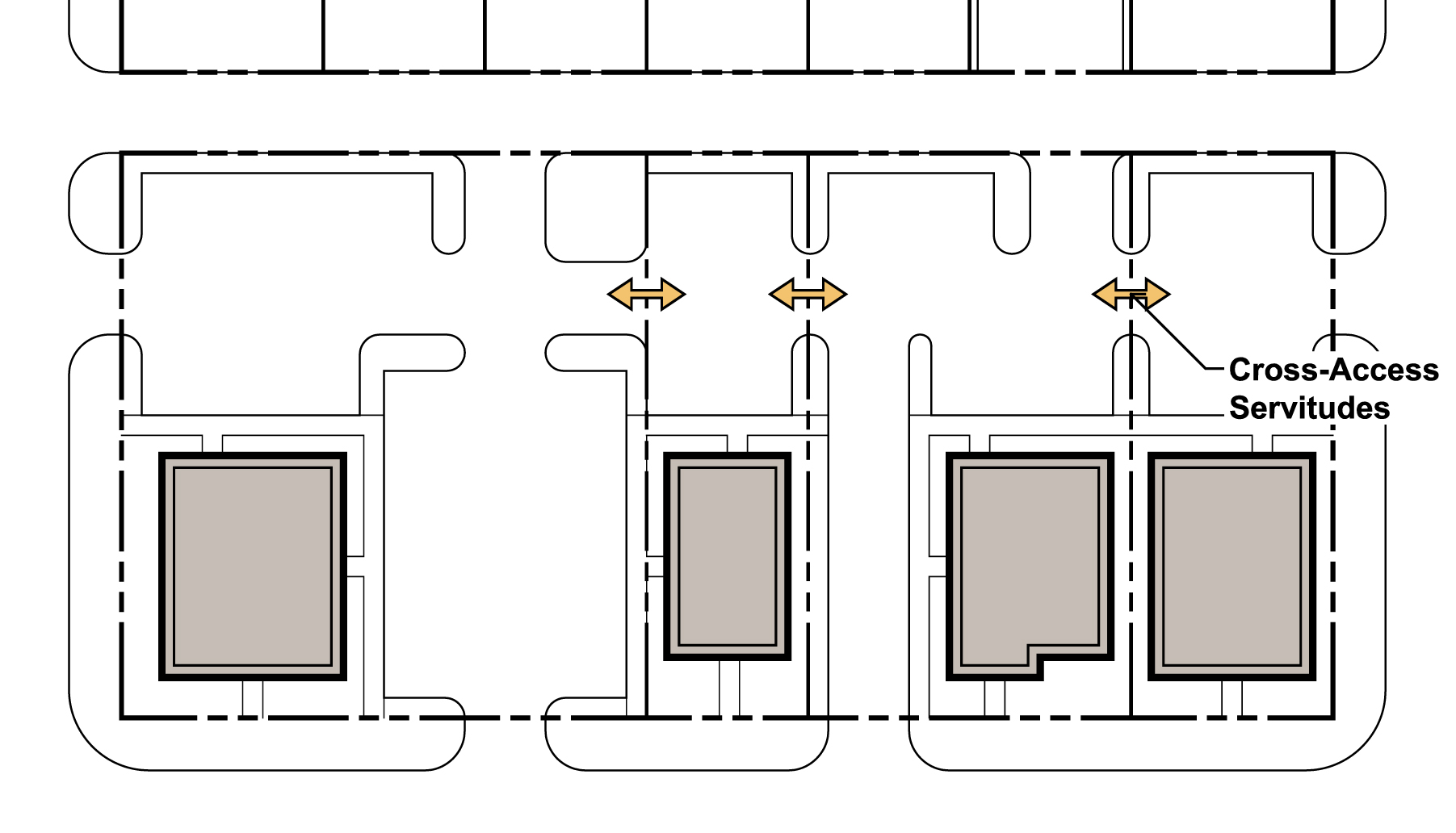New Orleans Comprehensive Zoning Ordinance
Printed: 4/25/2024 8:09:00 AM
22.11 Driveway and Parking Pad Design
22.11.A Driveway Design
22.11.A.1 Residential Driveways, Excluding Multi-Family and Townhouse Dwellings
a. A residential driveway that provides access to a garage is limited to a maximum of twelve (12) feet in width at the front property line. A driveway apron, the width of the garage, as measured from the garage walls, is permitted to extend for a distance (depth) of twenty (20) feet from the garage doors before tapering back to the required driveway width for access to the additional spaces. Driveways that do not terminate in a garage are limited to twelve (12) feet in width. (See Figure 22-8: Residential Driveway Width). The Department of Safety & Permits Director may exercise discretion of this general rule based on the location of the garage and its distance from the curb.
b. Driveways shall be located a minimum of one (1) foot from the side lot line. However, a residential driveway may be shared by adjacent lots. This shared driveway location is only allowed if agreed to by the owners of each lot, and the agreement is recorded as a shared driveway servitude on each plat of survey and submitted to the Department of Safety and Permits.
FIGURE 22-8: RESIDENTIAL DRIVEWAY WIDTH
DETACHED GARAGE DRIVEWAY WIDTH
 ATTACHED GARAGE DRIVEWAY WIDTH
ATTACHED GARAGE DRIVEWAY WIDTH

Adopted by Ord. 29126, 8-12-22, ZD016/22
22.11.A.2 Multi-Family and Townhouse Dwellings, and Non-Residential Driveways
a. Except for access to loading berths, driveways shall be a maximum of twelve (12) feet for one-way drives, and a maximum of twenty-four (24) feet for two-way drives, subject to review by the Department of Public Works.
b. Driveways, off-street parking areas and access aisles for multi-family residential and non-residential parking lots shall be designed in accordance with Figure 22-2.
22.11.B Curb Cuts
1. Curb cuts shall be limited to as few as possible, as determined by and with the permission of the Department of Public Works. Single-family dwellings are limited to one (1) curb cut, except as permitted below.
a. Circular drives are permitted only in the Rural Residential and Suburban Neighborhood Districts, except in the S-LRS1 District where they are prohibited. Circular drives shall meet all of the following standards:
i. An area is provided in the drive for a parking space. The parking space accessed by a circular drive shall be allowed to be located in between the front property line and the front facade of the principal structure.
ii. There is a minimum of three (3) feet between the drive and the side lot lines.
iii. The lot width is fifty (50) feet or greater.
iv. Approval is received from the Department of Public Works regarding the curb cuts.
v. None of the required yard and bulk requirements are violated.
b. In the Suburban Neighborhood Districts, where existing two-family dwellings have been developed with two (2) curb cuts serving two (2) driveways, the curb cut and driveway configurations are deemed conforming and may be repaired, maintained, and replaced.
2. Curb cuts are limited to a maximum width of twenty-four (24) feet for two-way circulation, and a maximum width of twelve (12) feet for one-way circulation unless the Director of the Department of Public Workds determines that circumstances require wider curb cuts for turning efficiency and/or safety. Curb cut widths are measured where a curb cut intersects with the property line.
3. Curb cuts are prohibited over the critical root zone of any tree as determined by the Department of Parks and Parkways.
4. Notwithstanding any other provisions of this Article, curb cuts for off-street parking or loading facilities are prohibited on the streets listed below (See Figure 22-9: Prohibited Curb Cut Locations). If no other means of vehicle access is available on these streets, a conditional use may be applied for but, as part of the evaluation, the Department of Public Works shall certify that there is no way to provide access on some other street. The following streets are restricted:
a. St. Charles Avenue, Howard Avenue to Canal Street, including the curvilinear portion of St. Charles Avenue that abuts the public space known as Lee Circle.
b. Canal Street, Claiborne Avenue to Convention Center Boulevard.
c. Magazine Street, Calliope Street to Canal Street.
d. Poydras Street, Claiborne Avenue to Convention Center Boulevard.
e. Julia Street, St. Charles Avenue to Convention Center Boulevard.
f. Camp Street, Andrew Higgins Drive to Canal Street.
g. Andrew Higgins Drive, St. Charles Avenue to Convention Center Boulevard.
h. N. Rampart Street, Canal Street to Iberville Street.
i. Howard Avenue, St. Charles Avenue to Baronne Street.
j. Baronne Street, Howard Avenue to Canal Street.
k. Convention Center Boulevard, Canal Street to Calliope Street.
l. Loyola Avenue, Canal Street to Calliope Street.
m. Carondelet Street, Canal Street to Howard Avenue.
n. Bourbon Street, Canal Street to Iberville Street.
o. Tulane Avenue, North Claiborne Avenue to Loyola Avenue/Elk Place.
p. Entire length of West End Boulevard.
q. Entire length of Pontchartrain Boulevard.
r. Royal Street, Canal Street to Iberville Street.
s. Decatur Street, Canal Street to Iberville Street.
t. Chartres Street, Canal Street to Iberville Street.
u. Dauphine Street, Canal Street to Iberville Street.
FIGURE 22-9: PROHIBITED CURB CUT LOCATIONS

Adopted by Ord. 29126, 8-12-22, ZD016/22; Ord. 29148, 9-1-22, ZD 42/22
22.11.C Cross-Access Servitudes
1. Adjacent commercial uses that possess dedicated parking areas are encouraged to provide a cross-access drive to allow circulation between sites. For new commercial, office, and service uses, a system of joint use driveways and cross-access servitudes is encouraged where feasible. Commercial property owners are encouraged to pursue cross-access with neighboring property owners at the time of development. (See Figure 22-10: Cross-Access Servitudes)
2. Joint use driveways and cross-access servitudes shall incorporate the following:
a. A minimum width of twelve (12) feet with no adjacent parking to ensure two-way travel aisles to accommodate automobiles, service vehicles and loading vehicles.
b. Bump-outs and other design features to make it visually obvious that the abutting properties are tied together.
c. A unified access and circulation plan for coordinated or shared parking areas.
3. Pursuant to this section, property owners who establish cross-access servitudes shall:
a. Record a servitude allowing cross-access to and from properties served by the joint use driveways and cross-access servitude.
b. Record a servitude that remaining access rights along the roadway will be dedicated to the City, and that any pre-existing driveways will be closed and eliminated after construction of the joint-use driveway.
c. Record a joint maintenance agreement defining the maintenance responsibilities of each property owner.
FIGURE 22-10: CROSS-ACCESS SERVITUDES

22.11.D Parking Pad Design for Single-Family and Two-Family Residential Uses
Single-family and two-family dwellings are permitted a paved parking pad, subject to the following requirements:
1. Parking pads are prohibited in the required front yard or required corner side yard.
2. Parking pads are prohibited between the front façade and the front lot line and shall be located behind the front building line of the house. The parking pad shall be of sufficient depth so that the parked auto does not encroach into the required front yard. At least fifty percent (50%) or more of the combined width of the front building line and parking pad shall be the principal structure. (See Figure 22-11: Parking Pad Design)
3. Parking pads may be located within the required interior side or rear yard but shall be located a minimum of one (1) foot from any lot line.
4. Parking pads must be a minimum of eight and a half (8.5) feet in width and eighteen (18) feet in length.
5. All driveways shall comply with the requirements of Paragraph A above.
6. The maximum coverage requirements for the lot may not be exceeded to accommodate a parking pad.
7. Parking pads may be surfaced with a durable, impermeable, all-weather material or a permeable paving system. Parking pads shall be designed so that they do not hold standing water and drain toward the front of the lot.
8. For the purposes of the Ordinance, the regulations within this section also apply to parking strips, in conjunction with Article 22, Section 22.8.E. (See Figure 22-4: Parallel Parking Strips).
FIGURE 22-11: PARKING PAD DESIGN

Adopted by Ord. 29126, 8-12-22, ZD016/22